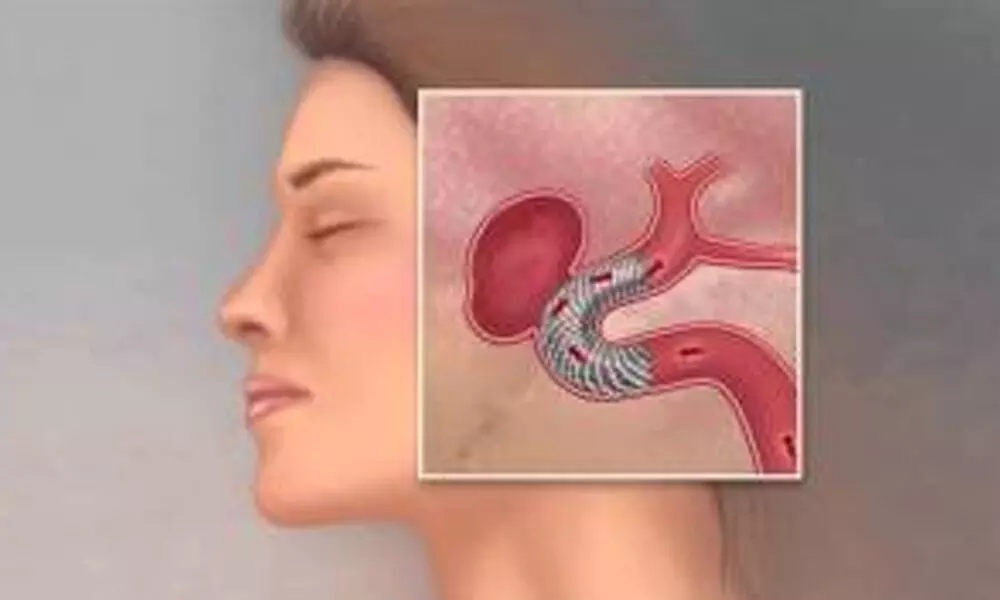New generation flow diverter surgery saves two lives

New generation flow diverter surgery saves two lives
A 28-year-old pregnant woman developed a sudden onset of severe headache and vomiting. After initial management through painkillers and medicines to relieve nausea and vomiting, urgent magnetic resonance imaging (MRI) was advised.
Bengaluru: A 28-year-old pregnant woman developed a sudden onset of severe headache and vomiting. After initial management through painkillers and medicines to relieve nausea and vomiting, urgent magnetic resonance imaging (MRI) was advised.
The MRI revealed a brain infarct that happens due to blockage of an artery as well as bleeding in the subarachnoid space of the brain. Further investigation through an angiogram revealed two aneurysms (a ballooned and weakened area of artery). With two lives at stake and ruling out of routine treatment through metallic coils, the patient was treated with a newer generation flow diverter.
Dr Vikram Huded, Senior Consultant, Interventional Neurologist and Head of Neurology, Narayana Health Institute of Neurosciences, said, "Subarachnoid hemorrhage (SAH) is a type of brain stroke occurring due to bleeding in the subarachnoid space and comprises around 3% of all strokes. Traumatic SAH is the commonest form and is treated in lines of other accompanying brain injuries resulting from direct or indirect mechanical impact to the skull and brain. Aneurysmal SAH is the commonest form of spontaneous SAH and results from rupture of an aneurysm- a ballooned-out area in the wall of a brain artery."
This is a serious condition and may be life-threatening resulting in immediate death in around 15% of the sufferers i.e., these individuals succumb even before reaching a medical facility. The death rate of the affected ones may reach up to 35% at 30 days from the time of onset and several of the surviving individuals may remain disabled for life, he said.
The global incidence of this disease is 9 per 100,000 people and varies from one region to another ranging from 4.2 per 100,000 people in South and Central America to 22.7 per 100,000 in Japan.
"The exact incidence in the Indian population is unknown. The incidence in the Indian population may be towards the lower end of the spectrum. However, given the large population in India, there is a need to raise awareness on Subarachnoid hemorrhage cases," said Dr. Huded.
Though the exact risk factors remain unknown in most, some of the known risk factors include smoking, hypertension (high blood pressure), heavy alcoholism, drugs like cocaine, and certain rare genetic syndromes (e.g., autosomal dominant polycystic kidney disease).
Speaking on the pregnant woman's case, Dr. Huded said, "This was a complicated case as there were two lives at stake and a lot of contraindications. CT scan could not be used because the radiation would have affected the foetus. Angiograms has to be done with utmost caution to expose the mother to radiation while preventing foetus at the same time. Like diagnosis, treatment was also challenging because routine treatment with metallic coils was not an option."
He added, "We decided to use a newer generation flow diverter. The complicated endovascular procedure was undertaken from just a pinhole-sized puncture from a leg artery. It was a demanding procedure. After 3 months the patient gave birth to a healthy child and now both mother and child are happy and healthy."
The case is testimony to the fact that timely diagnosis and intervention are of utmost importance for better outcomes. The initial signs of the neurological condition can be as simple as headache and vomiting. If simple signs do not go away after initial medication, it's wise to seek a specialist opinion.















